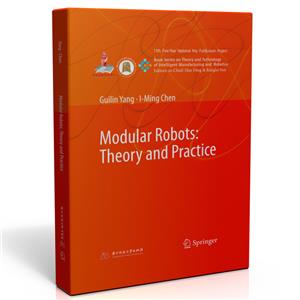-
>
公路車寶典(ZINN的公路車維修與保養秘籍)
-
>
晶體管電路設計(下)
-
>
基于個性化設計策略的智能交通系統關鍵技術
-
>
花樣百出:貴州少數民族圖案填色
-
>
山東教育出版社有限公司技術轉移與技術創新歷史叢書中國高等技術教育的蘇化(1949—1961)以北京地區為中心
-
>
鐵路機車概要.交流傳動內燃.電力機車
-
>
利維坦的道德困境:早期現代政治哲學的問題與脈絡
Modular Robots: Theory and Practice(模塊化機器人理論與應用) 版權信息
- ISBN:9787568073646
- 條形碼:9787568073646 ; 978-7-5680-7364-6
- 裝幀:一般膠版紙
- 冊數:暫無
- 重量:暫無
- 所屬分類:>
Modular Robots: Theory and Practice(模塊化機器人理論與應用) 本書特色
作者團隊為模塊化機器人設計研究領域的先驅者,研究成果具有較強的 性。
Modular Robots: Theory and Practice(模塊化機器人理論與應用) 內容簡介
This book introduces the latest advances in modular robotics, and presents a unified geometric framework for modeling, analysis, and design of modular robots, including kinematics, dynamics, calibration, and configuration optimization. Supplementing the main content with a wealth of illustrations, the book offers a valuable guide for researchers, engineers and graduate students in the fields of mechatronics, robotics, and automation who wish to learn about the theory and practice of modular robots.
Modular Robots: Theory and Practice(模塊化機器人理論與應用) 目錄
1.1 Motivation
1.2 Past Research and Development Efforts
1.3 Overview of This Book
2 ModuleDesigns
2.1 Module Design Requirements
2.2 Joint Modules
2.2.1 Revolute Joint Modules
2.2.2 Prismatic Joint Modules
2.3 Link Modules
3 Modular Robot Representation
3.1 Graphs
3.1.1 Basic Graph Definitions
3.1.2 Matrix Representation ofGraphs
3.2 Kinematic Graphs
3.3 Reclassification of Links and Joints
3.4 Assembly Incidence Matrix
4 Modular Serial Robot Kinematics
4.1 Introduction
4.2 Geometric Background and the POE Formula
4.2.1 Geometric Background
4.2.2 The POE Formula
4.3 Forward Kinematics
4.3.1 Dyad Kinematics
4.3.2 Forward Kinematics for a Tree-Structured Modular Robot
4.4 Inverse Kinematics
4.4.1 Differential Kinematics Model for a Single Branch
4.4.2 Differential Kinematics Model for a Tree-Structured Robot
4.4.3 Computation Examples
4.4.4 Remarks on Computation Results
5 Kinematic Calibration for Modular Serial Robots
5.1 Introduction
5.2 Kinematic Calibration Models
5.2.1 Basic Calibration Models
5.2.2 An Iterative Least-Squares Algorithm
5.2.3 Kinematic Calibration of Tree-structured Robots
5.3 ComputationExamples
5.3.1 Calibration of a three-module Robot
5.3.2 Calibration of a SCARA Type Robot
5.3.3 Calibration of a Tree-structured Robot
6 Modular Serial Robot Dynamics
6.1 Introduction
6.2 Newton-Euler Equation for a Link Assembly
6.3 Dynamic Formulation for a Tree-Structured Modular Robot
6.3.1 Recursive Newton-Euler Algorithm
6.3.2 Closed Form Equations of Motion
6.3.3 Remarks on the Dynamics Algorithms
6.3.4 Implementation and Examples
6.4 Inverse and Forward Dynamics Problem
6.4.1 Inverse Dynamics
6.4.2 Forward Dynamics
7 Optimization of Modular Serial Robot Configurations
7.1 Introduction
7.2 General Design Methodology
7.3 Optimization Model
7.3.1 Definition of Robot Tasks
7.3.2 Design Parameters and the Search Space
7.3.3 Objective Function
7.3.4 Performance Constraints
7.4 Evolutionary Algorithm
7.4.1 Coding Scheme
7.4.2 AIM Generating Scheme
7.4.3 Genetic Operators on AIMs
7.4.4 Implementation of the Evolutionary Algorithm
7.5 Computation Examples
8 Modular Parallel Robot Kinematics
8.1 Introduction
8.2 Displacement Analysis
8.2.1 Forward Displacement Analysis
8.2.2 Inverse Displacement Analysis
8.3 Instantaneous Kinematics Analysis
……
9 Kinematic Calibration for Modular Parallel Robots
References
Modular Robots: Theory and Practice(模塊化機器人理論與應用) 作者簡介
Guilin Yang received the B.E. and M.E. degrees from Jilin University, Changchun, Jilin, China, in 1985 and 1988 respectively, and the Ph.D. degree from Nanyang Technological University in 1999, all in mechanical engineering. He is currently the deputy president of Ningbo Institute of Materials Technology and Engineering, Chinese Academy of Sciences. He is also the director of Zhejiang Key Laboratory of Robotics and Intelligent Manufacturing Equipment Technology. His research interests include precision electromagnetic actuators, compliant mechanisms, parallel-kinematics machines, cable-driven robots, modular robots, and robotic automation systems. He has published over 300 technical papers in referred journals and conference proceedings, authored 3 books, and filed 50 patents. He was a recipient of R&D 100 Awards in 2014. I-Ming Chen received the B.S. degree from the Taiwan University, Taipei, Taiwan, in 1986, and the M.S. and Ph.D. degrees from California Institute of Technology, Pasadena, CA, USA, in 1989 and 1994, respectively, all in mechanical engineering. He is currently a Full Professor with the School of Mechanical and Aerospace Engineering, Nanyang Technological University, Singapore. He works on several different topics in robotics, such as mechanism, actuator, human-robot interaction, and logistics and construction robotics. Dr. Chen is a Fellow of Academy of Engineering, Singapore, a Fellow of ASME, a Fellow of IEEE, and the Editor-in-chief of the IEEE/ASME Transactions on Mechatronics. He has published over 430 technical articles in refereed journals, conferences and book chapters, and authored 4 books.
- >
新文學天穹兩巨星--魯迅與胡適/紅燭學術叢書(紅燭學術叢書)
- >
巴金-再思錄
- >
【精裝繪本】畫給孩子的中國神話
- >
我從未如此眷戀人間
- >
龍榆生:詞曲概論/大家小書
- >
名家帶你讀魯迅:朝花夕拾
- >
二體千字文
- >
唐代進士錄
















